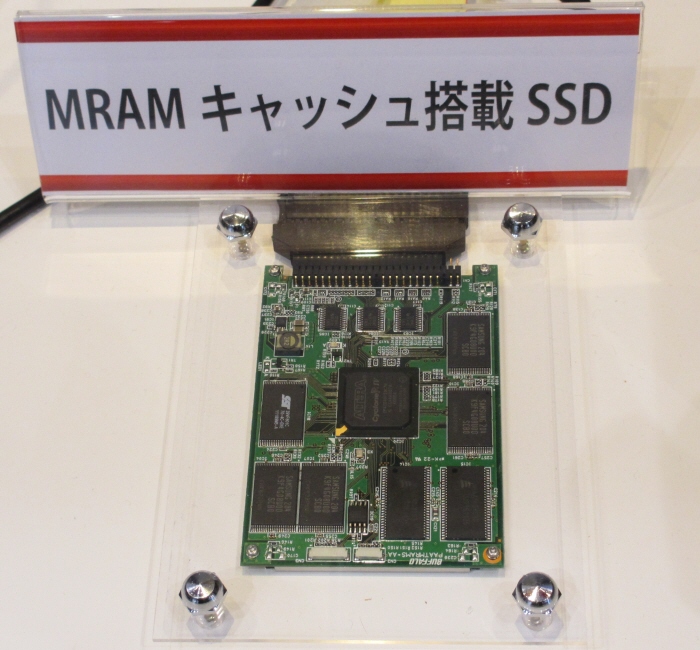Buffalo Shows SSDs with MRAM Cache
Buffalo said it will soon begin sampling a new solid state disk drive that complements its standard NAND flash storage memory with MRAM that is used as cache memory.
Typically, SSDs use flash as cache memory as opposed to the much faster DRAM, but Buffalo says that MRAM can bridge the gap between NAND flash and DRAM and provide a much better cache solution as a result.
Flash is used today as it has non-volatile properties and does not lose its content like DRAM when the power is cut off. MRAM, which is similar to DRAM structure, is also a non-volatile memory technology, but faster than flash. The technology has been in development for more than a decade. In the 2005 time frame, MRAM was believed to have an opportunity to succeed flash as a mass-market solid state memory technology, but has been held back by low density and, as a result, high cost.
In the Buffalo device, however, the SSD uses 4 GB of NAND flash storage and just 8 MB of MRAM cache, which makes the use of MRAM a much more compelling proposition. It's not a consumer device either as the SSD will be targeted at extreme industrial applications and for integration in machinery that runs at up to 85 degrees Celsius. Buffalo states that the use of MRAM makes its SSD more reliable overall and reduces power consumption as well. However, we know that new technologies and expensive ideas tend to trickle down from the high-end if they make sense. It's not entirely unreasonable to foresee an MRAM SSD for the consumer market at some point in the future.
Get Tom's Hardware's best news and in-depth reviews, straight to your inbox.

Douglas Perry was a freelance writer for Tom's Hardware covering semiconductors, storage technology, quantum computing, and processor power delivery. He has authored several books and is currently an editor for The Oregonian/OregonLive.
-
halcyon Would there be any significant performance/reliability increase if MRAM did trickle down to consumer products? If not, I'd rather have more economical SSDs based on tech that's already mature.Reply -
blazorthon HalcyonWould there be any significant performance/reliability increase if MRAM did trickle down to consumer products? If not, I'd rather have more economical SSDs based on tech that's already mature.Reply
MRAM can be about as fast as SRAM if implemented properly (it's even being looked into as a replacement for SRAM in CPU cache because of it's high performance), even faster than DRAM, so yes, there is a definite advantage to having it beyond the fact that MRAM is one of the most reliable storage technologies ever. -
eddieroolz HalcyonWould there be any significant performance/reliability increase if MRAM did trickle down to consumer products? If not, I'd rather have more economical SSDs based on tech that's already mature.Reply
Advancements are necessary at all times, even if industry begins settling on a de facto standard. -
halcyon blazorthonMRAM can be about as fast as SRAM if implemented properly (it's even being looked into as a replacement for SRAM in CPU cache because of it's high performance), even faster than DRAM, so yes, there is a definite advantage to having it beyond the fact that MRAM is one of the most reliable storage technologies ever.Awesome, so let's bring it on to the enthusiasts so that the average joe (spelled "me") can afford it one day.Reply -
blazorthon shin0bi272Id still rather have PCM chips but this is cool too.Reply
MRAM is more reliable and faster than PCM, although PCM seems cheaper at this time. It's all trade-offs.
(MRAM could actually be made cheap, but it has certain problems. There are multiple methods used to alleviate them, but they are never all used in one device because the different methods are all owned by different people. If they got together, it could be made a lot cheaper and even faster without sacrificing reliability. Greed is kinda stupid in how it will avoid greater avenues for making money if other people who you aren't on great terms with also profit from a venture.
HalcyonWould there be any significant performance/reliability increase if MRAM did trickle down to consumer products? If not, I'd rather have more economical SSDs based on tech that's already mature.
HalcyonAwesome, so let's bring it on to the enthusiasts so that the average joe can afford it one day.
Why did people vote your earlier comment down? I thought that it was a legitimate question. -
halcyon blazorthonWhy did people vote your earlier comment down? I thought that it was a legitimate question.Ahhh, given my Apple-neutral/objectivist stance I'm used to it...I didn't even notice.Reply -
blazorthon eddieroolzAdvancements are necessary at all times, even if industry begins settling on a de facto standard.Reply
When technological "advancements" turn out to not be a good deal better than former tech, then improvements on the former, more mature technology can outpace the newer "advancing" technology. For example, hard drives are among the oldest technologies still in almost universal use in modern computers and despite their age and disadvantages against newer technology, they are still far more suitable for many situations. In fact, if you want a high speed hard drive, then they can be made. A 15KRPM drive with four read/write heads would surprise you (no modern drives have more than one read/write head anymore, but it could be done) in just how fast it could be for both sequential and even random throughput. Just because something is newer, doesn't' make it better. That is what Halcyon's question was about, whether or not MRAM was actually an improvement over the older technologies, at least that's what I thought the question was about. -
robisinho halcyonWould there be any significant performance/reliability increase if MRAM did trickle down to consumer products? If not, I'd rather have more economical SSDs based on tech that's already mature.Reply
This was a good comment with a ton of reasonable responses it makes no sense people voted it down. Anyways...
MRAM won't make it to consumers unless they end up with extra chips they need to clear. Most of the time when high speed cache is needed, they use DRAM. The system can be designed to overcome power loss-based data loss by either integrating a capacitor (old school method) or by carefully balancing the components so there is enough inert charge in the system to write out the cache before losing its remaining charge (they actually do this in devices like I think the samsung 830).
"It's not entirely unreasonable to foresee an MRAM SSD for the consumer market at some point in the future."
It is entirely unreasonable unfortunately. The reason cost is so high is because feature size is so high. This in turn means it cannot run as fast as conventional DRAM, RERAM, etc. (because of heat/power concerns, etc)
RERAM (also) is sorta the death knell of any hope of old-school memristor tech, and recently prototype reram chips have hit the news...
